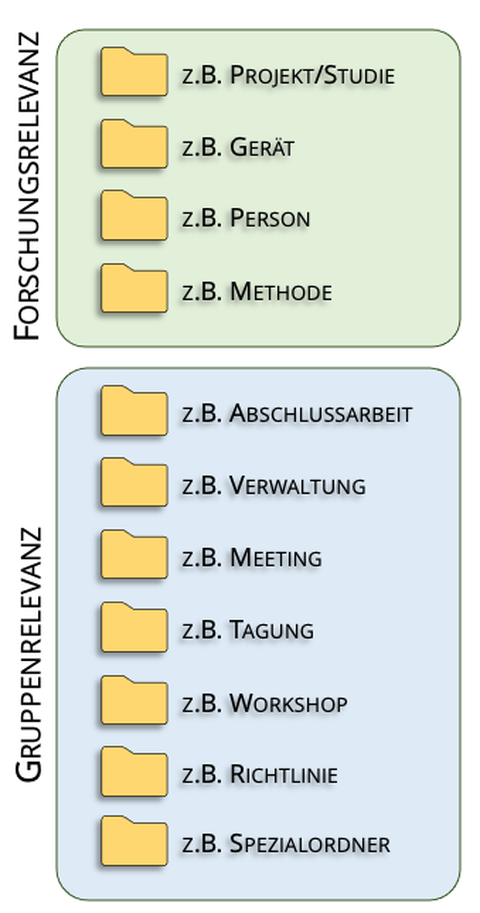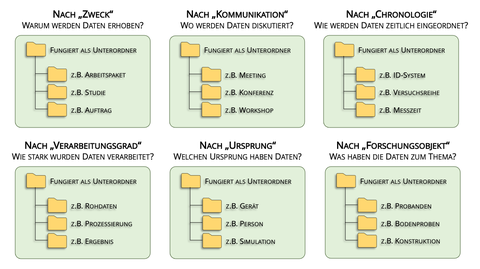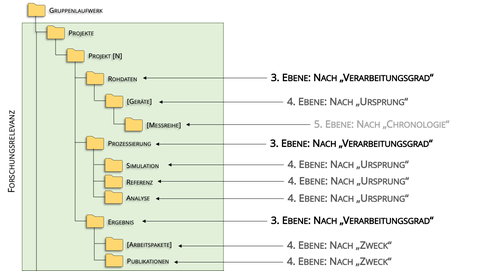28.06.2023
Ordnerstruktur entwickeln - Logik der Ordnerhierarchie erarbeiten
Nachdem im ersten Schritt 1gemeinsam in der Gruppe eine Übersicht der Daten gewonnen wurde, beginnt die Arbeit an der Namensfindung der einzelnen Ordner. Zu diesem Zeitpunkt stellen Forschungsgruppen oftmals Fragen an die Kontaktstelle Forschungsdaten, wie z.B.: Wie viele Hierarchieebenen sind sinnvoll? Welche Kategorien sollte man wählen? Wie viele Unterordner darf man anlegen?
Unsere Empfehlung lautet hierbei stets: "Es ist zunächst wichtiger eine Logik der Ordnerhierarchie zu entwickeln und eindeutig zu kommunizieren, als sich an vorgegebenen Regeln zu orientieren". Um eine solche Logik der Ordnerhierarchie zu entwickeln, arbeiten wir zusammen mit den Forschungsgruppen für jede Hierarchieebene und jeden Unterordner jeweils einen "Strukturierungsansatz" aus.
Auf der ersten Ebene einer Ordnerstruktur sollten ausschließlich Ordner existieren, die vom Namen her jedem Mitarbeiter geläufig sind ("Jeder kennt diesen Begriff"). So zeigt sich in der Abb.1 eine Aufteilung in forschungsrelevante und gruppenrelevante Kategorien. In gruppenrelevanten Kategorien werden administrative Dokumente, die die Zusammenarbeit innerhalb der Gruppe betreffen abgelegt. Für den forschungsrelevanten Bereich sollte man sich gemeinsam auf eine übergeordnete erste Strukturierung festlegen (z.B. nach Projekt oder Studie oder Person).
Nachdem die erste Hierarchieebene nach "Gruppen- und Forschungsrelevanz" unterteilt wurde, widmet man sich im weiteren Verlauf den nun neu entstandenen Unterordnern und weist jedem einzelnen Unterordner einen eigenen Strukturierungsansatz zu. Hierfür kann man auf bereits etablierte Ansätze zurückgreifen (siehe Abb. 2) ohne auf diese beschränkt zu sein. Ordnernamen nach dem Zweck zu finden, bedeutet, dass der Grund der Datenerhebung im Vordergrund steht: Beispielsweise, ein Arbeitspaket im Projekt soll erfüllt werden. So würden sich Ordner auf der ersten Unterebene ergeben, die nach den Arbeitspaketen eines Projektes benannt sind. Auf einer weiteren Unterebene kann dann z.B. nach den Verarbeitungsgraden der Daten strukturiert werden, wenn in jedem Arbeitspaket zunächst Rohdaten, dann prozessierte Daten und danach finale Ergebnisse entstehen.
Ein Beispiel für eine praktische Anwendung der Strukturierungsansätze ist in Abb. 3 dargestellt. Die Festlegung eines Strukturierungsansatzes pro Unterordner erleichtert die Navigation in der Ordnerstruktur, da auf jeder Ebene eindeutig ist, warum die Unterordner existieren und welche Daten erwartet werden. Zusätzlich kann der Strukturierungsansatz in einer kleinen Unterstützungsdatei kurz beschrieben werden.
Jedoch kann die optimale Ordnerstruktur für eine Forschungsgruppe nicht theoretisch erdacht, sondern sollte praktisch erprobt werden. Aus diesem Grund empfehlen wir verschiedene Strukturen und Strukturierungsansätze in gemeinsamen Treffen auszuprobieren.
Haben Sie Interesse Ihre Ordnerstruktur nach dem dargestellten Verfahren zu aktualisieren? Haben Sie Anmerkungen oder Vorschläge?
Gerne unterstützen wir Sie bei Ihrem Vorhaben. Kontaktieren Sie uns dazu per E-Mail über Kontaktstelle Forschungsdaten, buchen Sie sich einen Termin, besuchen Sie unsere wöchentliche Sprechstunde oder nutzen Sie unser Weiterbildungsangebot.
Themenreihe "Ordnerstruktur entwickeln"
-
1. Warum es sich lohnt über Ordnerstrukturen nachzudenken
2. Übersicht gewinnen und Rahmen festlegen
3. Logik der Ordnerhierarchie festlegen
4. Spezielle Ordner anlegen
5. Die unscheinbaren Helfer




